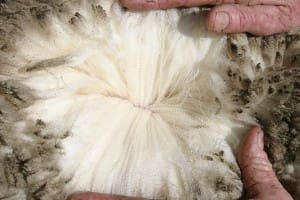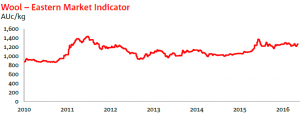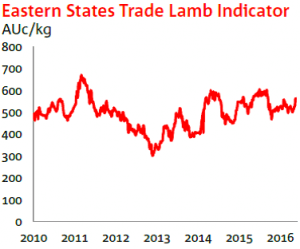 WOOL prices have been forecast by the National Australia Bank to rise more than 7 percent in the next financial year after a 14pc lift in 2015-16, underpinned by a lower $A-US dollar exchange rate.
WOOL prices have been forecast by the National Australia Bank to rise more than 7 percent in the next financial year after a 14pc lift in 2015-16, underpinned by a lower $A-US dollar exchange rate.
In the NAB Agribusiness May Rural Commodities Wrap, the bank’s analysts said after several years of unfavourable prices, wool producers have enjoyed a run-up in the AWEX Eastern Market Indicator since the second quarter of 2015.
The bank said wool is sensitive to movements in the Australian dollar exchange rate and its expectations for commodity prices in the coming year are underpinned by its forecasts for a generally lower $A, tracking in the high US60s range in late 2016 and 2017.
“This is likely to support local prices somewhat through challenging international conditions,” NAB said.
“While the $A strength earlier this year limited price upside, the recent fall in the exchange rate points to an upside for price.
“Overall, we forecast that prices will increase 14 percent in 2015-16 and 7.2pc in 2016-17, the NAB analysts said.
 The bank said the higher wool prices were forecast to offset lower production in 2015-16 and spur an increase in production in 2016-17.
The bank said the higher wool prices were forecast to offset lower production in 2015-16 and spur an increase in production in 2016-17.
“We forecast the value of Australian wool exports to increase 9pc in 2015-16 and 8.3pc 2016-17.”
Lamb and mutton prices to lift, production to fall
NAB is forecasting lamb and mutton prices to lift 4.2pc in 2015-16 and 0.6pc in 2016-17 as production decreases. The bank said its production and price forecasts for lamb reflect the moderately higher prices this year.
“Indeed, the Eastern States Trade Lamb Indicator has been trending upwards since 2013, albeit with strong seasonal variation reflecting the usual spring lamb flush.
“Production and exports have been elevated amid dry conditions over the past two years, but these levels were not sustainable and we see lamb and mutton production falling 7.5pc in 2015-16 and 6.1pc in 2016-17,” the bank said.
 “Overall we forecast the value of exports to fall 7.4pc in 2015-16 and a further 8.5pc in 2016-17 amid lower export volumes.”
“Overall we forecast the value of exports to fall 7.4pc in 2015-16 and a further 8.5pc in 2016-17 amid lower export volumes.”
No Reserve Bank rate rise before 2018
NAB said the Reserve Bank (RBA) cash rate cut in May has seen the Australian dollar fall quite rapidly, which is likely to provide support to Australian prices over the coming months.
Key points:
- Very low inflation has increased NAB’s confidence in the $A returning to below US70 cents later this year and remaining in the high 60s throughout 2017. In good news for agricultural exporters, NAB does not expect a sustained return above US70 cents until mid-2018.
- Australian agricultural commodity prices declined overall in April, with the NAB Rural Commodities Index falling 0.7pc in $A terms (but up 0.4pc in US dollar terms)
- Australia’s very low inflation in Q1 2016 was the primary reason the RBA cut rates to 1.75pc in May.
The bank does not expect the conditions for an RBA rate rise to be met before 2018.
NAB’s Rural Commodities Index includes 28 commodities (wheat, barley, sorghum, rice, oats, canola, chick peas, field peas, lupins, wool, cotton, sugar, wine grapes, beef, lamb, pork, poultry, dairy, apples, bananas, oranges, mangoes, strawberries, broccoli, carrots, lettuce, potatoes and tomatoes). The index is weighted annually according to the gross value of production of each industry in Australia.
Click here to read the NAB May Rural Commodities Wrap.
Source: NAB.


HAVE YOUR SAY